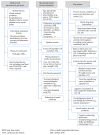Aging in HIV-Infected Subjects: A New Scenario and a New View
- PMID: 29430462
- PMCID: PMC5753008
- DOI: 10.1155/2017/5897298
Aging in HIV-Infected Subjects: A New Scenario and a New View
Abstract
The prevalence of HIV-infected people aged 50 years or older is increasing rapidly; the proportion will increase from 28% to 73% in 2030. In addition, HIV-infected individuals may be more vulnerable to age-related condition. There is growing evidence that the prevalence of comorbidities and other age-related conditions (geriatric syndromes, functional or neurocognitive/mental problems, polypharmacy, and social difficulties) is higher in the HIV-infected population than in their uninfected counterparts. However, despite the potential impact of this situation on health care, little information exists about the optimal clinical management of older HIV-infected people. Here we examine the age-related conditions in older HIV-infected persons and address clinical management according to author expertise and published literature. Our aim is to advance the debate about the most appropriate management of this population, including less well-studied aspects, such as frequency of screening for psychological/mental and social and functional capabilities.
Figures
References
Publication types
MeSH terms
LinkOut - more resources
Full Text Sources
Other Literature Sources
Medical
Molecular Biology Databases


